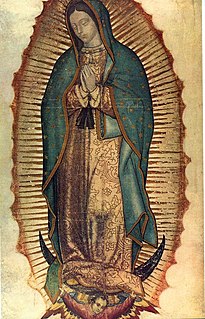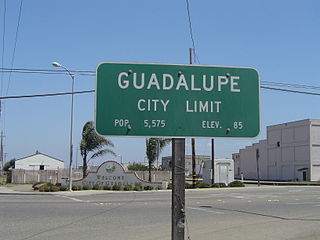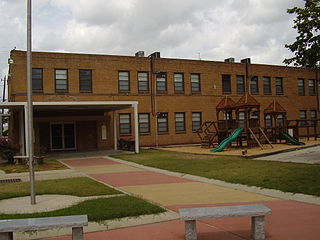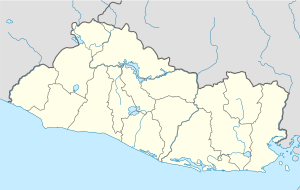
Our Lady of Guadalupe, also known as the Virgin of Guadalupe, is a Catholic title of the Blessed Virgin Mary associated with a series of five Marian apparitions in December 1531, and a venerated image on a cloak enshrined within the Basilica of Our Lady of Guadalupe in Mexico City. The basilica is the most-visited Catholic shrine in the world, and the world's third most-visited sacred site.

Guadalupe County is a county located in the U.S. state of Texas. As of the 2010 census, its population was 131,533. The county seat is Seguin. The county was founded in 1846 and is named after Guadalupe River.

Guadalupe is a small city located in Santa Barbara County, California. According to the U.S. Census of 2010, the city has a population of 7,080. Guadalupe is economically and socially tied to the city of Santa Maria, which is about ten miles to the east. It is located on Highway 1 immediately south of the Santa Maria River, and five miles east of the Pacific Ocean.

Seguin is a city in and the county seat of Guadalupe County, Texas, United States. As of the 2010 census, its population was 25,175. By 2019, its population was estimated to be 29,992.

The Treaty of Guadalupe Hidalgo, officially titled the Treaty of Peace, Friendship, Limits and Settlement between the United States of America and the Mexican Republic, is the peace treaty that was signed on February 2, 1848, in the Villa de Guadalupe Hidalgo between the United States and Mexico that ended the Mexican–American War (1846–1848). The treaty was ratified by the United States on March 10 and by Mexico on May 19. The ratifications were exchanged on May 30, and the treaty was proclaimed on July 4, 1848.

Gustavo A. Madero is one of the 16 municipalities into which Mexico City is divided.

José Guadalupe Posada Aguilar (1852–1913) was a Mexican political lithographer who used relief printing to produce popular illustrations. His work has influenced numerous Latin American artists and cartoonists because of its satirical acuteness and social engagement. He used skulls, calaveras, and bones to convey political and cultural critiques. Among his most enduring works is La Calavera Catrina.

The Guadalupe River mainstem is an urban, northward flowing 14 miles (23 km) river in California whose much longer headwater creeks originate in the Santa Cruz Mountains. The river mainstem now begins on the Santa Clara Valley floor when Los Alamitos Creek exits Lake Almaden and joins Guadalupe Creek just downstream of Coleman Road in San Jose, California. From here it flows north through San Jose, where it receives Los Gatos Creek, a major tributary. The Guadalupe River serves as the eastern boundary of the City of Santa Clara and the western boundary of Alviso, and after coursing through San José, it empties into south San Francisco Bay at the Alviso Slough.

The Guadalupe fur seal is one of six members of the fur seal genus Arctocephalus. Sealers reduced the population to just a few dozen by the late 19th century, but the species had recovered to 10,000 in number by the late 1990s. Many individuals can be found on Mexico's Guadalupe Island.

Guadalupe Island or Isla Guadalupe is a volcanic island located 241 kilometres (150 mi) off the west coast of Mexico's Baja California Peninsula and about 400 kilometres (250 mi) southwest of the city of Ensenada in the state of Baja California, in the Pacific Ocean. The various volcanoes are extinct or dormant.

The Guadalupe River runs from Kerr County, Texas, to San Antonio Bay on the Gulf of Mexico. It is a popular destination for rafting, fly fishing, and canoeing. Larger cities along it include Kerrville, New Braunfels, Seguin, Gonzales, Cuero, and Victoria. It has several dams along its length, the most notable of which, Canyon Dam, forms Canyon Lake northwest of New Braunfels.

The Basilica of Our Lady of Guadalupe is a Roman Catholic church, basilica, and National shrine of Mexico which houses the cloak containing the image of Our Lady of Guadalupe. The 1709 shrine was built in the North of Mexico City near the hill of Tepeyac, where the Virgin Mary is believed to have appeared to Saint Juan Diego Cuauhtlatoatzin. The basilica structure which now contains Juan Diego's cloak was completed in 1974.

Second Ward is a historical political district ward in the East End community in Houston, Texas. It was one of the four original wards of the city in the nineteenth century. The community known as the Second Ward today is roughly bounded by Buffalo Bayou to the north, Lockwood Avenue to the east, and railroad tracks to the south and west, although the City of Houston's "Super Neighborhood" program includes a section east of Lockwood.

South Mountain Community College is a public community college in Phoenix, Arizona. It is one of the ten colleges in the Maricopa County Community College District.

Guadalupe College was a private Baptist college for African Americans in Seguin, Texas. It was established in 1884 and opened officially in 1887. Its founding was chiefly due to the efforts of William B. Ball, who would later serve as its president. David Abner Jr. was president of Guadalupe College from 1891 to 1906, a 15-year tenure during which the college flourished and gained statewide recognition. At its height during his administration, the college had an enrollment of approximately 500 students.

Guadalupe is a neighborhood located in the North Zone of Rio de Janeiro, Brazil. It is surrounded by Barros Filho, Honório Gurgel, Marechal Hermes, Deodoro, Ricardo de Albuquerque, Costa Barros and Anchieta. Its designation is a homage to Our Lady of Guadalupe which main church in Rio de Janeiro is located in this neighbourhood. The neighbourhood was built as a project of former Casa Popular Foundation and it was inaugurated by president Getúlio Vargas. Are also notable in the neighbourhood the "Igloos of Guadalupe", a set of houses in hemisphere shape, looking like igloos, and built in the late 1940s on Calama street.

The Church of Our Lady of Guadalupe and St. Bernard is a Roman Catholic parish church in the Roman Catholic Archdiocese of New York, located at 328-332 West 14th Street in the Chelsea neighborhood of Manhattan, New York City. It was established in 2003 as a result of a parish merger of the Manhattan parishes of Our Lady of Guadalupe and St. Bernard's Church.

Our Lady of Guadalupe Catholic Church is a Roman Catholic church located in the Second Ward in the East End, Houston, Texas. It is a part of the Roman Catholic Archdiocese of Galveston-Houston.

Our Lady of Guadalupe Catholic School is a Roman Catholic K-8 school in the Second Ward in the East End, Houston, Texas. It is the parish school of the Our Lady of Guadalupe Catholic Church of the Roman Catholic Archdiocese of Galveston-Houston.
Our Lady of Guadalupe School v. Morrissey-Berru, 591 U.S. ___ (2020), was a United States Supreme Court case involving the ministerial exception of federal employment discrimination laws. The case extends from the Supreme Court's prior decision in Hosanna-Tabor Evangelical Lutheran Church & School v. Equal Employment Opportunity Commission which created the ministerial exception based on the Establishment and Free Exercise Clauses of the United States Constitution, asserting that federal discrimination laws cannot be applied to leaders of religious organizations. The case, along with the consolidated St. James School v. Biel, both arose from rulings in the United States Court of Appeals for the Ninth Circuit that found that federal discrimination laws do apply to others within a religious organization that serve an important religious function but lack the title or training to be considered a religious leader under Hosanna-Tabor. The religious organization challenged that ruling on the basis of Hosanna-Tabor. The Supreme Court ruled in a 7–2 decision on July 8, 2020 that reversed the Ninth Circuit's ruling, affirming that the principles of Hosanna-Tabor, that a person can be serving an important religious function even if not holding the title or training of a religious leader, satisfied the ministerial exception in employment discrimination.




















